Chimichurris, Dominican Street Burgers
The word chimichurri refers to a South American sauce used in sandwiches and on grilled meats. Popular in Argentina, it is made from parsley, garlic, olive oil, red wine vinegar, and a little dried red pepper, and it was a vital ingredient in the sausage-inna-bun type sandwich we covered back in 2015 called Choripán.
The word Chimichurri also refers to a type of hamburger sandwich served from carts as a street food in the Dominican Republic. This sandwich contains a thin, oblong patty of seasoned ground beef, formed to fit into an oval-shaped pan de agua roll, and topped with cabbage, onion, tomato, and a type of pink sauce similar to salsa golf.
(According to Wikipedia, the word chimichurri also refers to a pizza sauce in Mexico consisting of “mayonnaise, mustard, chile de árbol, white vinegar, garlic, oil and salt.” I am intrigued but that is beyond the scope of this article. Here is a video on how to make it though.)
The Argentine style chimichurri sauce isn’t used in the Dominican-style Chimichurri burgers, and the two items have nothing to do with each other. Except that maybe they do. According to accounts of the sandwich’s history, it evolved from the choripanes sold by an Argentine immigrant’s food cart starting in the 1970s. The South American sandwiches called Choripán–a portmanteau combining chorizo, or sausage, and pan, or bread–feature a combination of bright red paprika-heavy chorizo with the green chimichurri sauce on a long bread roll. The chimichurri burger consists of a highly seasoned patty of ground meat served with sauce in a long bread roll. The story may be apocryphal but it doesn’t strain the imagination to believe it.
As with many street foods, the Dominican sandwich varies slightly from stand to stand, and there is no real set recipe. However, the commonalities of the sandwich include:
- A burger patty made of seasoned ground beef, flattened and cooked on a griddle
- shredded or very thinly sliced cabbage
- pink sauce, a mixture of mainly mayonnaise and ketchup, usually with a small amount Worcestershire (or salsa inglesa) and orange juice as well.
Sometimes it is plain shredded cabbage, sometimes it is pickled to some extent. Usually it is cooked on the same griddle as the burger, often soaking up some of the burger juices as well. Onion and tomato are usually added as well. Sometimes lettuce. Never cheese.
With street food sandwiches, I often like watching videos on Youtube to see some technique or get some clue as to how they’re constructed. There are a lot of videos on Youtube showing home cooks recreating these burgers. I’ve found fewer videos documenting them in the wild. Here is one: note the bright red color of the meat even after it’s cooked (1:39 in the video) and how it’s cut straight out of a plastic tube, almost as if it were Mexican chorizo.
I’ve found a few other videos of street preparations as well, and in those videos, for the most part, the street vendors are using separate squeeze bottles for mayonnaise and ketchup rather than a single, combined pink sauce. Yet Wikipedia and the numerous home cooks making these burgers insist on the pink sauce. I’ll try it their way, but please note that I may be full of it.
In a video entitled “The Real Dominican Chimi, Easy and Super Tasty” a Youtube home cook seasons her meat with a combination of canned sofrito, garlic, black pepper, Adobo seasoning, and achiote. The achiote could go a long way toward explaining the unnaturally red coloring of the beef patties in the video above. She also lightly pickles her cabbage and red onion, which appealed to me.
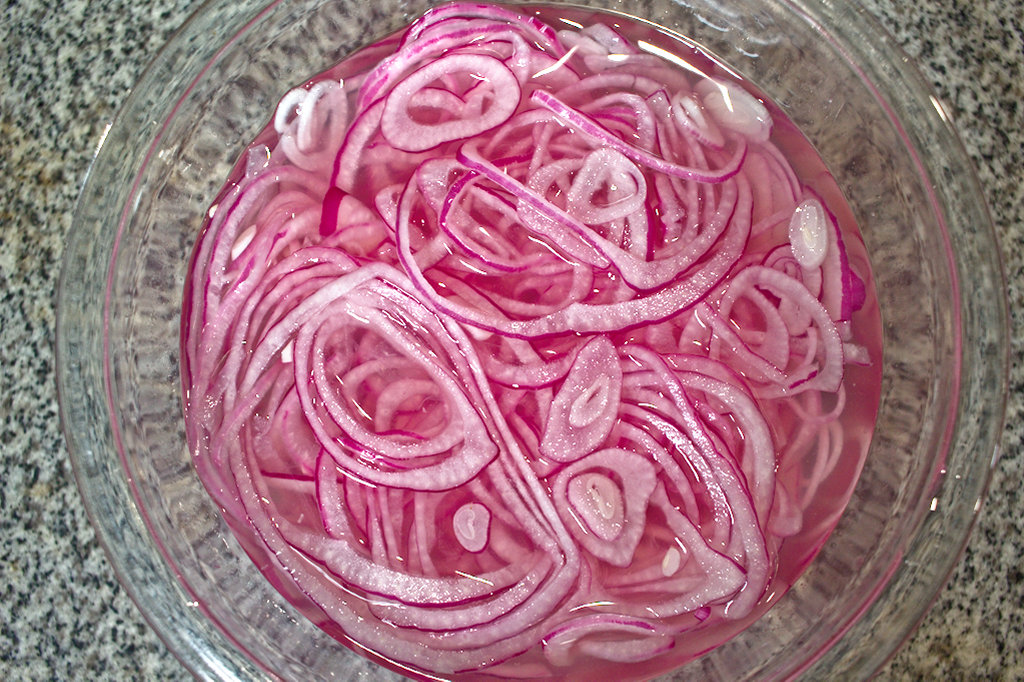
For the onions, I sliced them very thinly with a mandoline, salted them, and left them to ferment for a few hours. Then I added a very lightly acidic 7:1 mixture of water and cider vinegar and let them pickle for a few more hours. I treated the cabbage the same way.
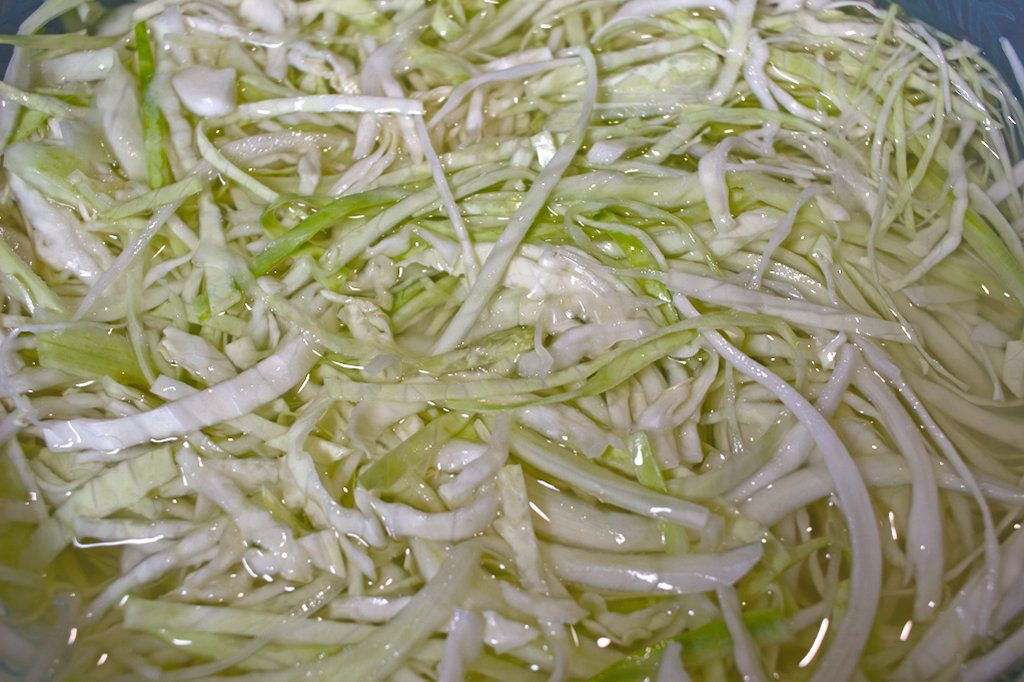
For the beef, I seasoned 2lbs of 80/20 ground chuck with a tablespoon of Adobo seasoning, a tablespoon of achiote powder, 3-4 cloves worth of freshly minced garlic, and plenty of freshly cracked black pepper. I shaped the meat into thin patties roughly the size and shape of the bolillo rolls I bought to make the sandwiches. (The less said about my failed attempt to make pan de agua the better. Besides, my local Mexican bakery makes fantastic bolillos.)

Bolillos from St. Jude’s Bakery in Midlothian 
Bolillo-shaped patties of seasoned meat
I also selected some of the late-season tomatoes I’m still pulling from my garden every few days. They are not the prettiest, but they are still loads better than anything I could get from a grocery store.
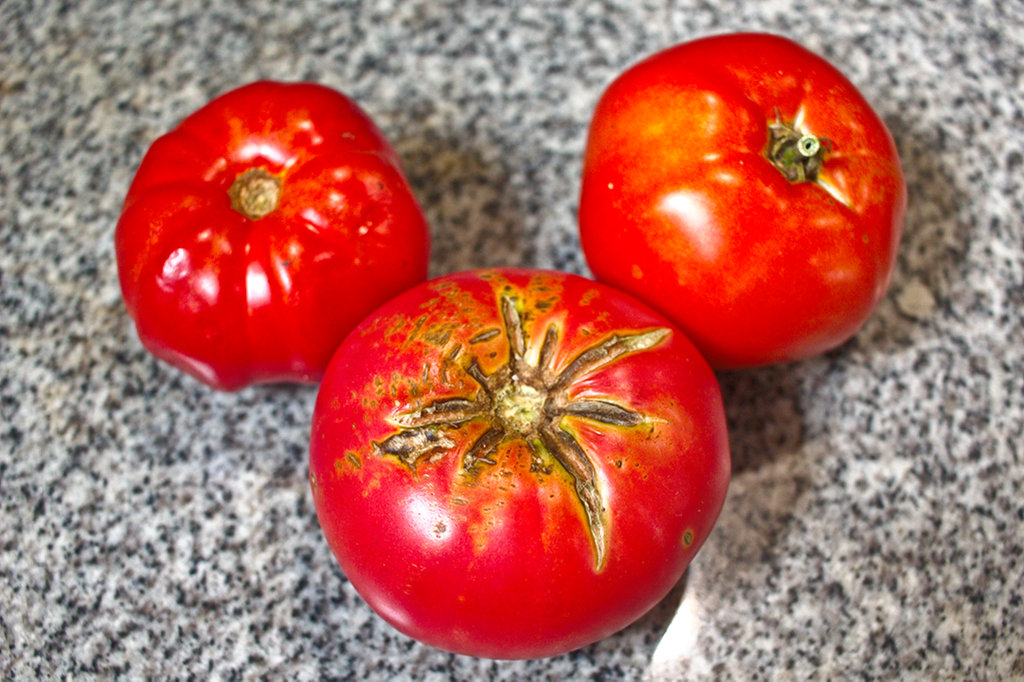
I used my nonstick electric griddle to cook the beef patties, though I feel that a stainless or even cast iron griddle would provide more opportunities to get flavor into the cabbage. For what is cabbage, if not an opportunity to soak up flavors? Still, even with the non-stick coating of the electric griddle, the cooking beef left plenty of red-tinted oil behind, and even a highly-seasoned buildup of almost-burnt spices.
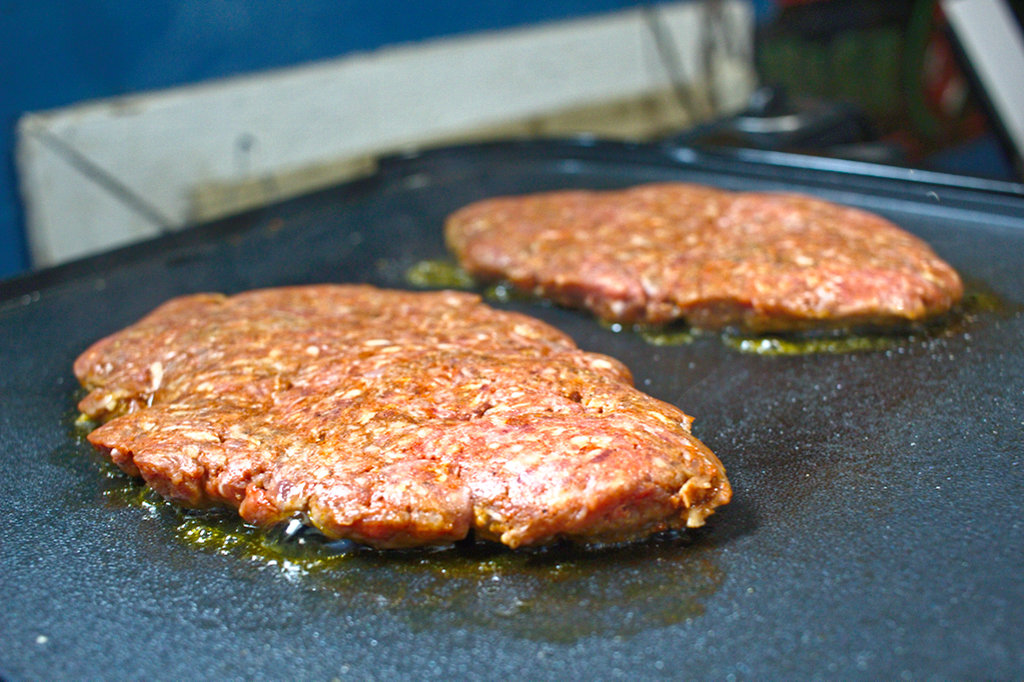
It took several minutes per side to get a nice browned crust on the meat. This is not a high-end steakhouse burger, or even a bloody pub burger. We are not looking for a pink interior. We want some nice browning on the outside, and the meat cooked all the way through.
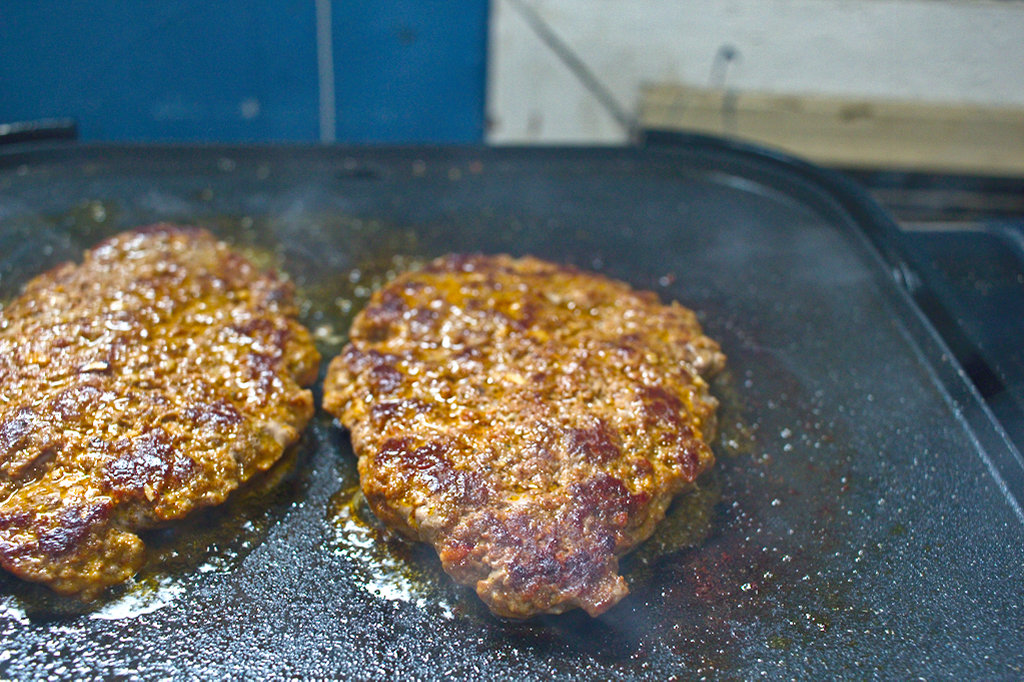
After the patties were done, I transferred them to a warm plate temporarily and deglazed the griddle with a few handsful of the cabbage.
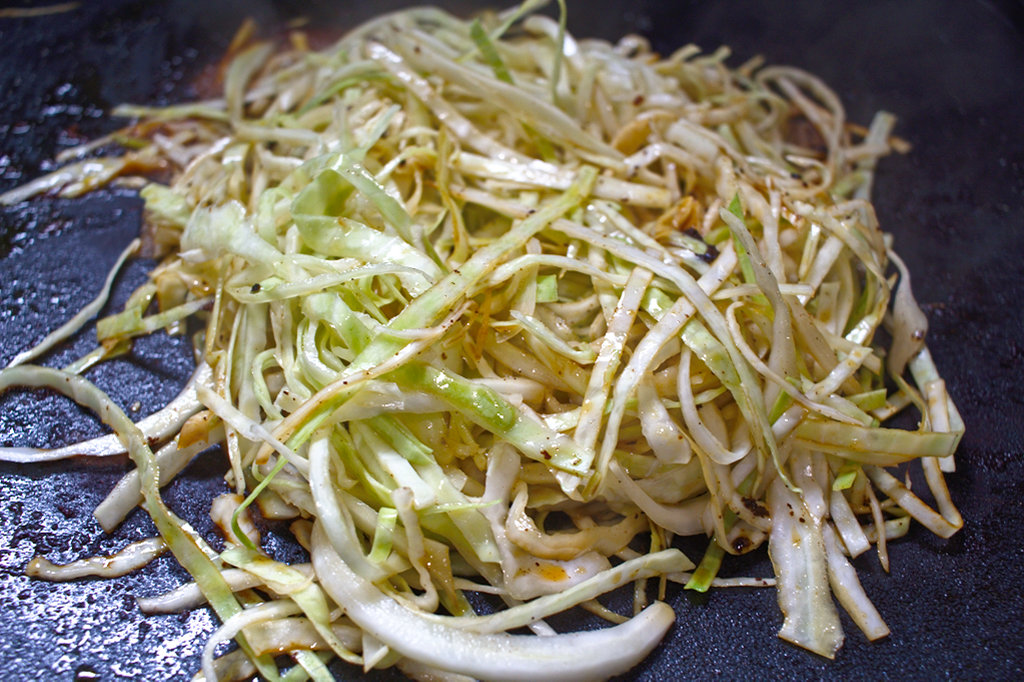
The cabbage should only cook for a few minutes, turned and flipped and stirred frequently–not long enough to soften it much if at all, just long enough to let it absorb some of the flavor the patties left behind. You could add some Worcestershire or pink sauce to it at this point if you wanted. Every chimi recipe is different. I did not. I just mopped up that burger grease with it.
Time to assemble
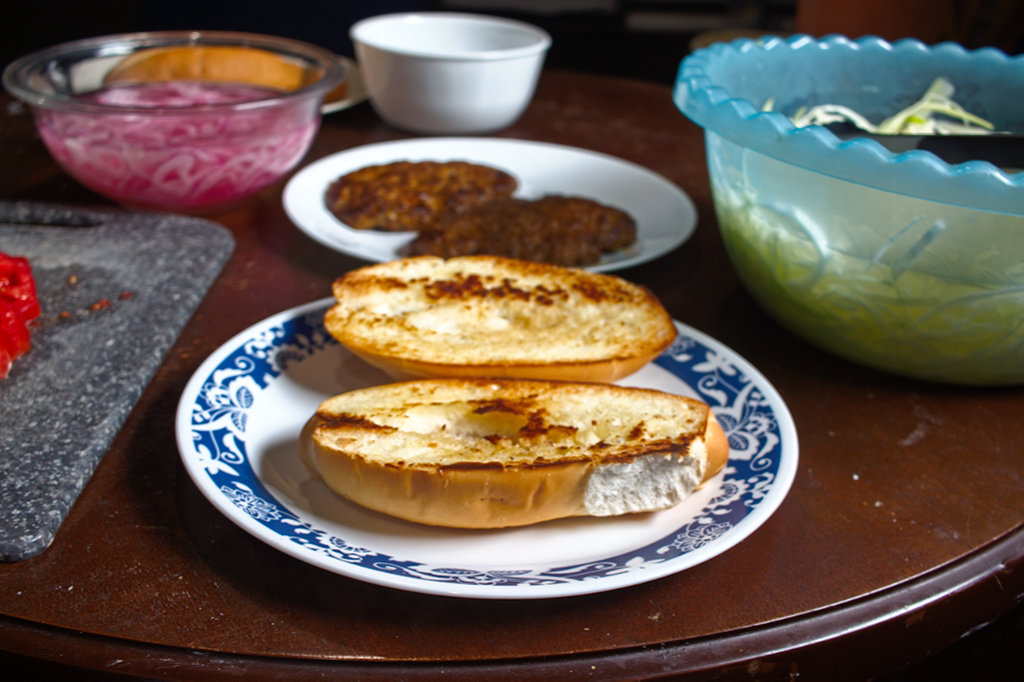
I began by toasting the bolillos on the clean griddle, before I even cooked the burger patties, and setting them aside to remain warm while I worked on the rest of the ingredients
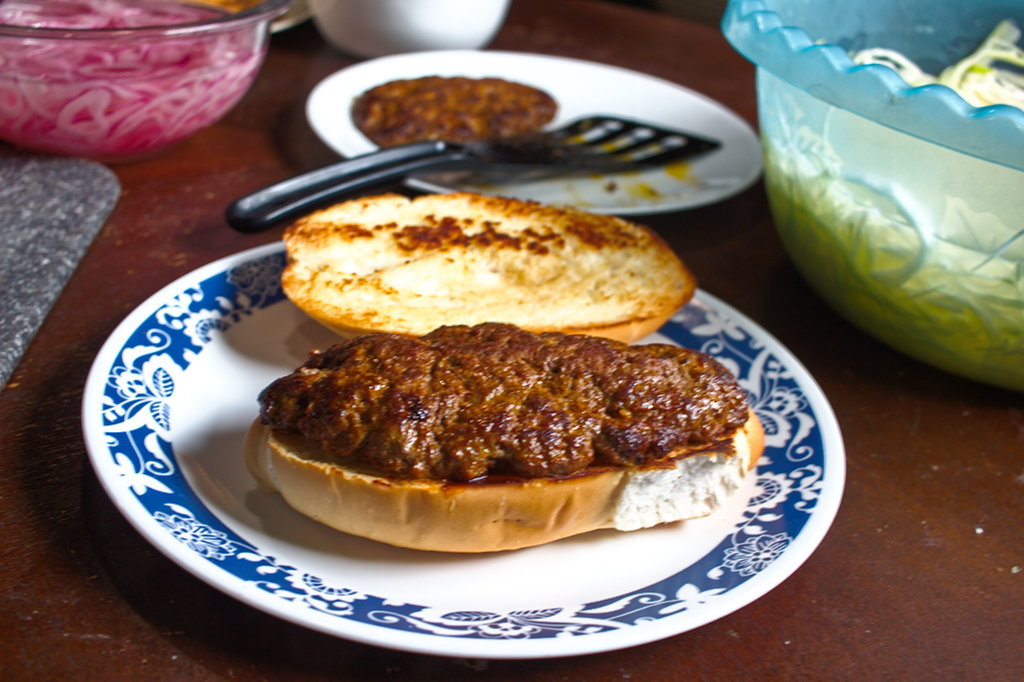
The seasoned beef did not have quite the brilliant red I expected with the achiote powder I’d added to the beef. However, I did do a good job of matching the patty to the shape and size of the bread.
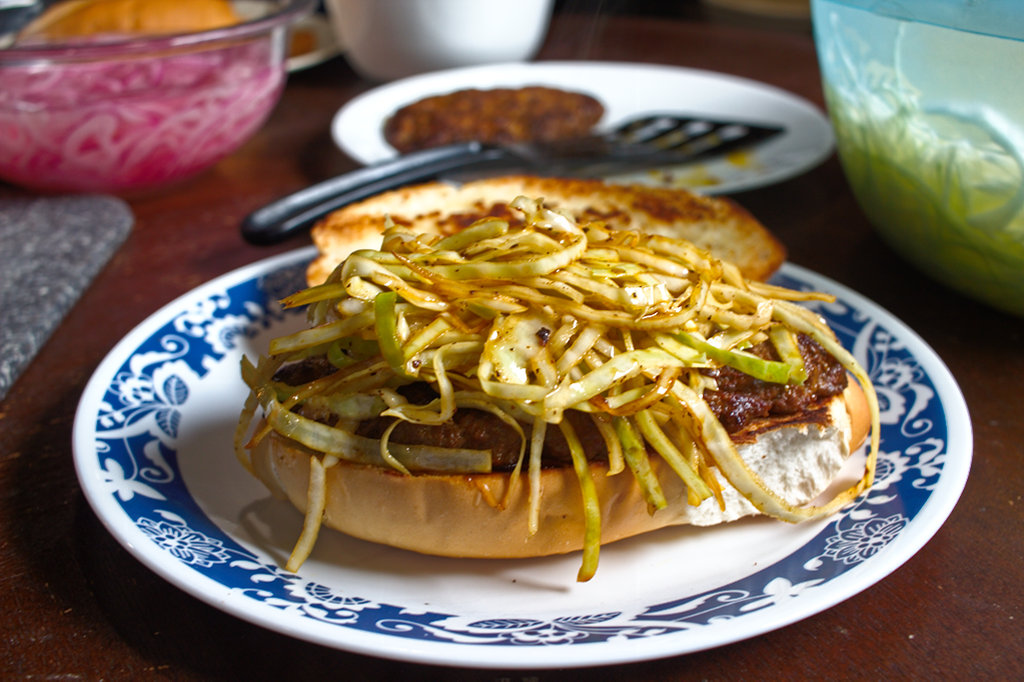
After the burger comes the cabbage, and thisis what makes the chimi unique among burgers, so I piled it on. A true afficionado of the chimichurri might even think I skimped on the cabbage a bit, but I used quite a bit per burger.
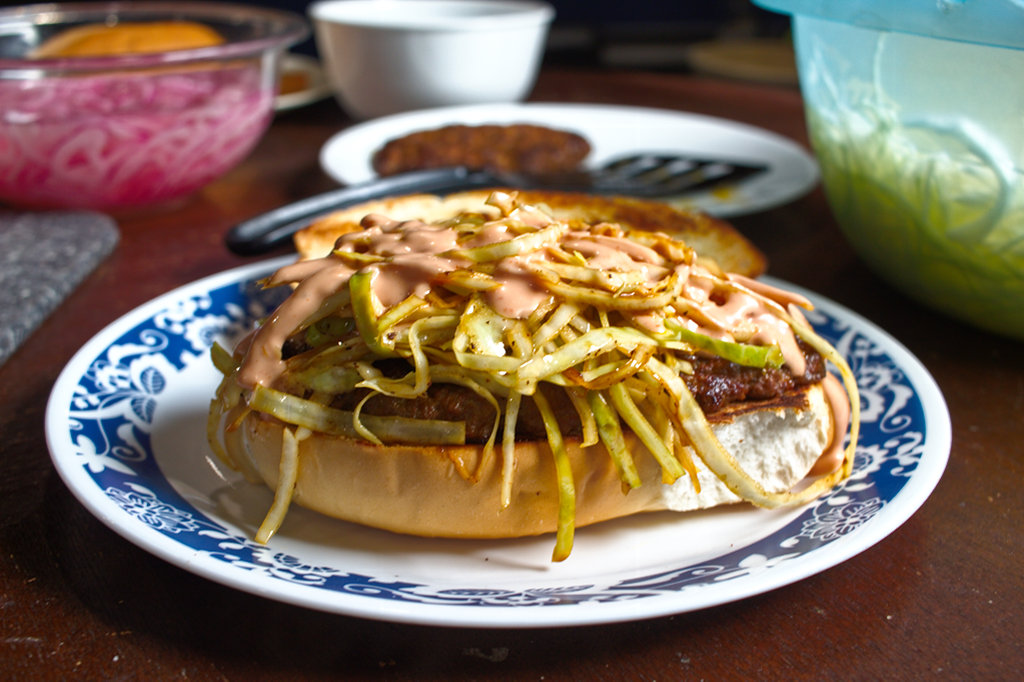
Next came the sauce, and again, I used plenty of it. This sauce was a combination of slightly more ketchup than mayonnaise, with a bit of Worcestershire sauce and freshly squeezed orange juice. It’s addictive–the sweetness of the ketchup and orange juice with the savory and sour flavors offered by the mayonnaise and Worcestershire sauce. The burger will be messy regardless–don’t skimp on the sauce.
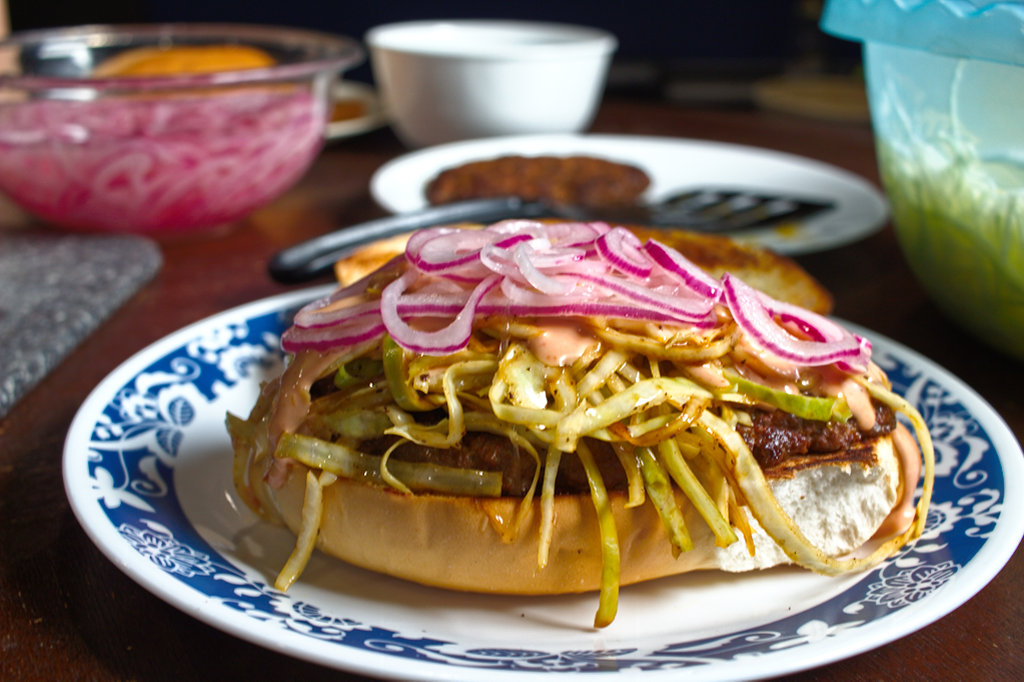
These are the pickled onions, but since they’re just lightly pickled the pungency of the raw onion is still somewhat there, its edges smoothed by the pickling but the flavors augmented by the salt and sour of the brine.
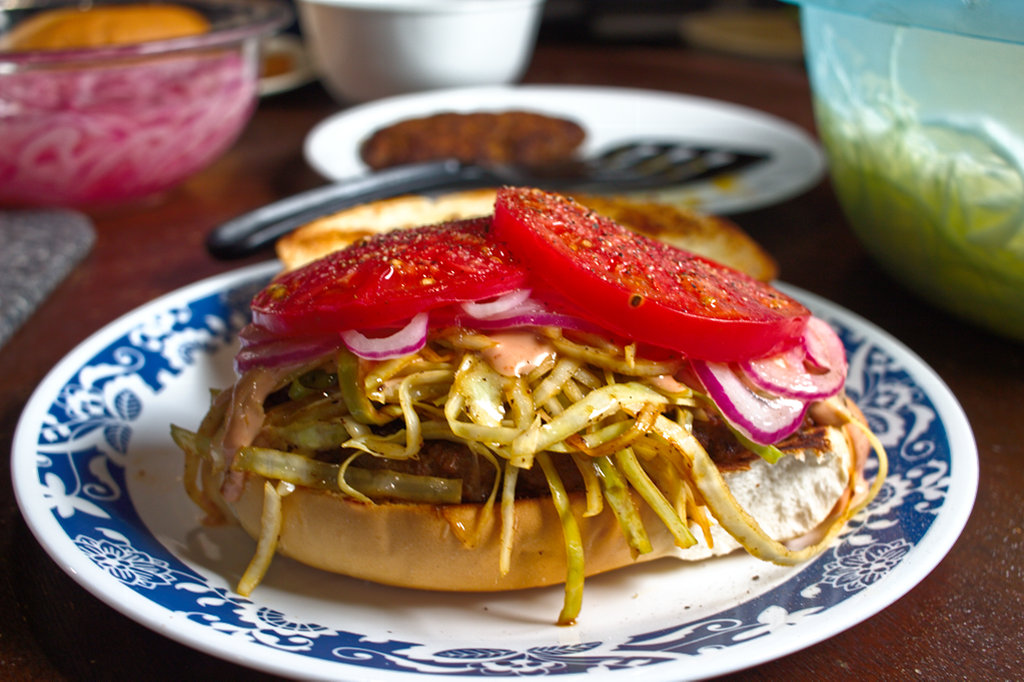
Finally I added two glorious slices of garden-fresh tomatoes, seasoned with sea salt and freshly cracked black pepper.
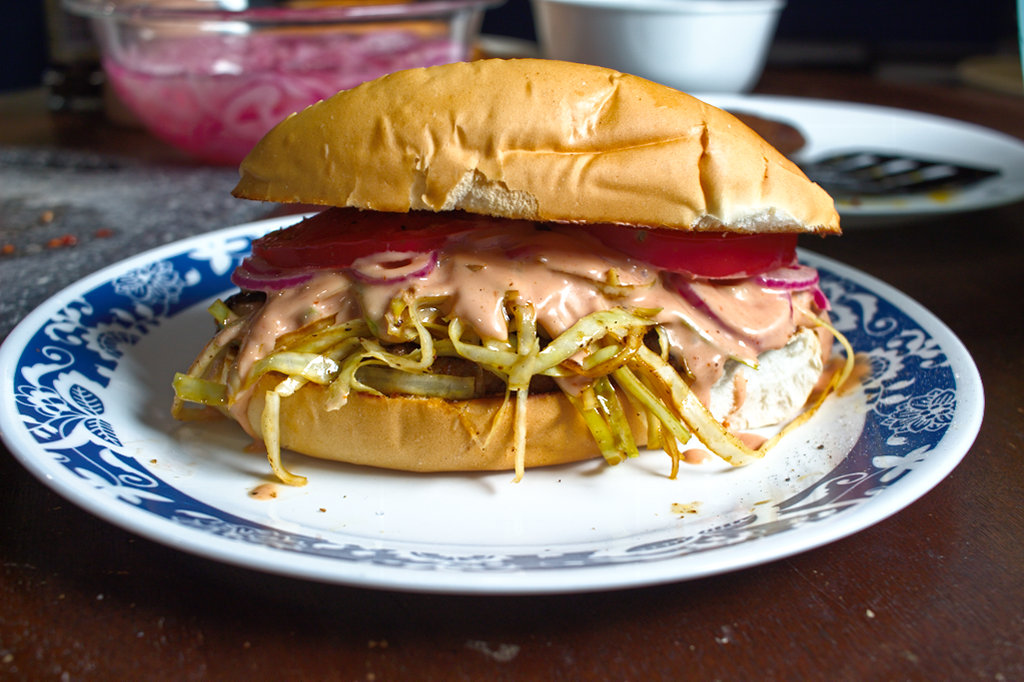
First observation: these sandwiches are enormous. That is a full-sized dinner plate, and the sandwich covers it pretty completely. There’s no way I can eat the whole thing.
Second observation: these sandwiches are delicious. I’m sure as hell going to try to eat the whole thing.
The crunchy yet very slightly wilted cabbage is itself a revelation. Why don’t we use cabbage on burgers more often? Cole slaw is a common enough topping on barbecue sandwiches, but the mildly salt, mildly sour, heavily-sauced shreds of cabbage used here are as much a main ingredient of the sandwich as the highly-seasoned meat patty is. The onions and tomatoes make their presence known, but the sandwich would not change much fundamentally if you removed them.
The common wisdom with hamburgers is that you want to work the meat minimally, keep it nice and loosely packed rather than dense and sausagey. Like last month’s cevapcici, the Chimichurri burger is the opposite of that. The highly seasoned meat gets mixed well, resulting in a more tightly-packed patty. As with sausage, though, the seasoning justifies what may be lost in texture.
In fact this patty reminds me of a regional sandwich I tried recently, the “poor boy” local to exurban South Chicagoland. Like the Chimichurri, these are oblong patties made of seasoned beef, served on a more substantial bread roll than the typical hamburger bun. Unlike the Chimichurri though, they come with ketchup, pickle, mustard, and grilled onion, even cheese if you want it. Shredded cabbage and pink sauce are not on offer.
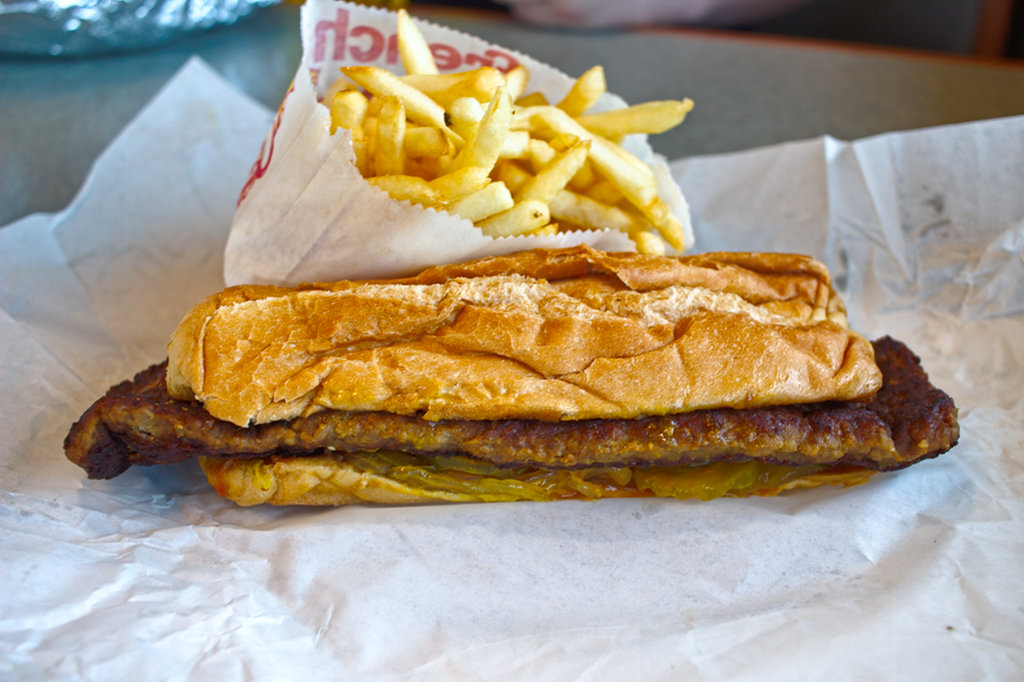
It’s hard to overstate how unique and delicious the cabbage topping makes these burgers. I can only suggest that you watch one of the many many videos on Youtube and try making them for yourself. I don’t think that mixing the pink sauce up is necessary–you could get by with using individual dispensers of mayo, ketchup, and mustard. If you do that, though, don’t skimp with the Worcestershire on the burger or the cabbage.

I like sandwiches.
I like a lot of other things too but sandwiches are pretty great


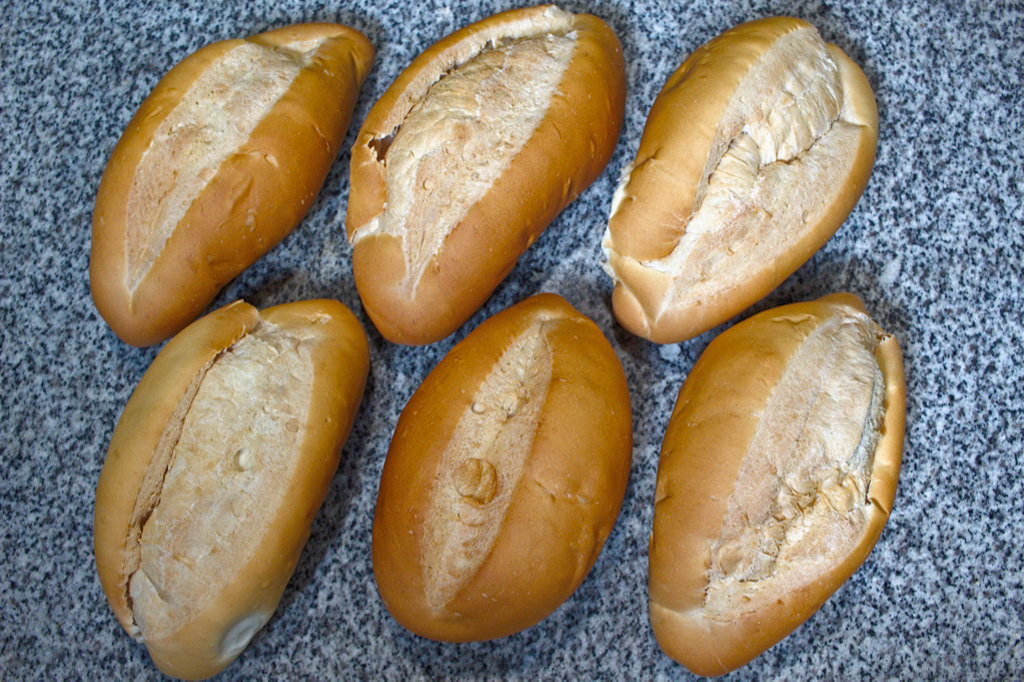
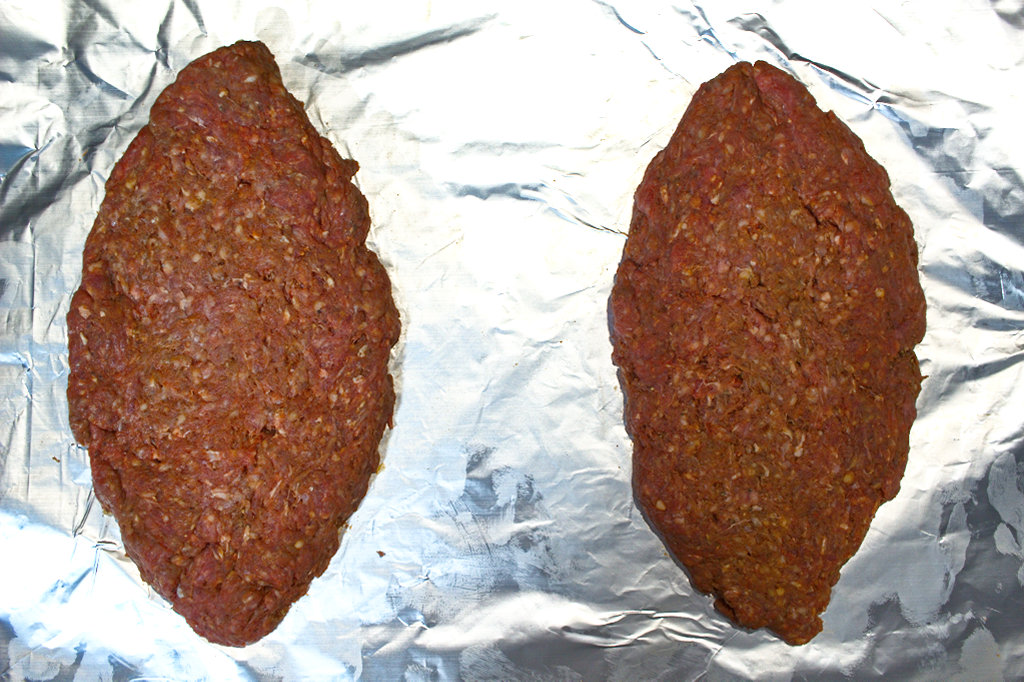
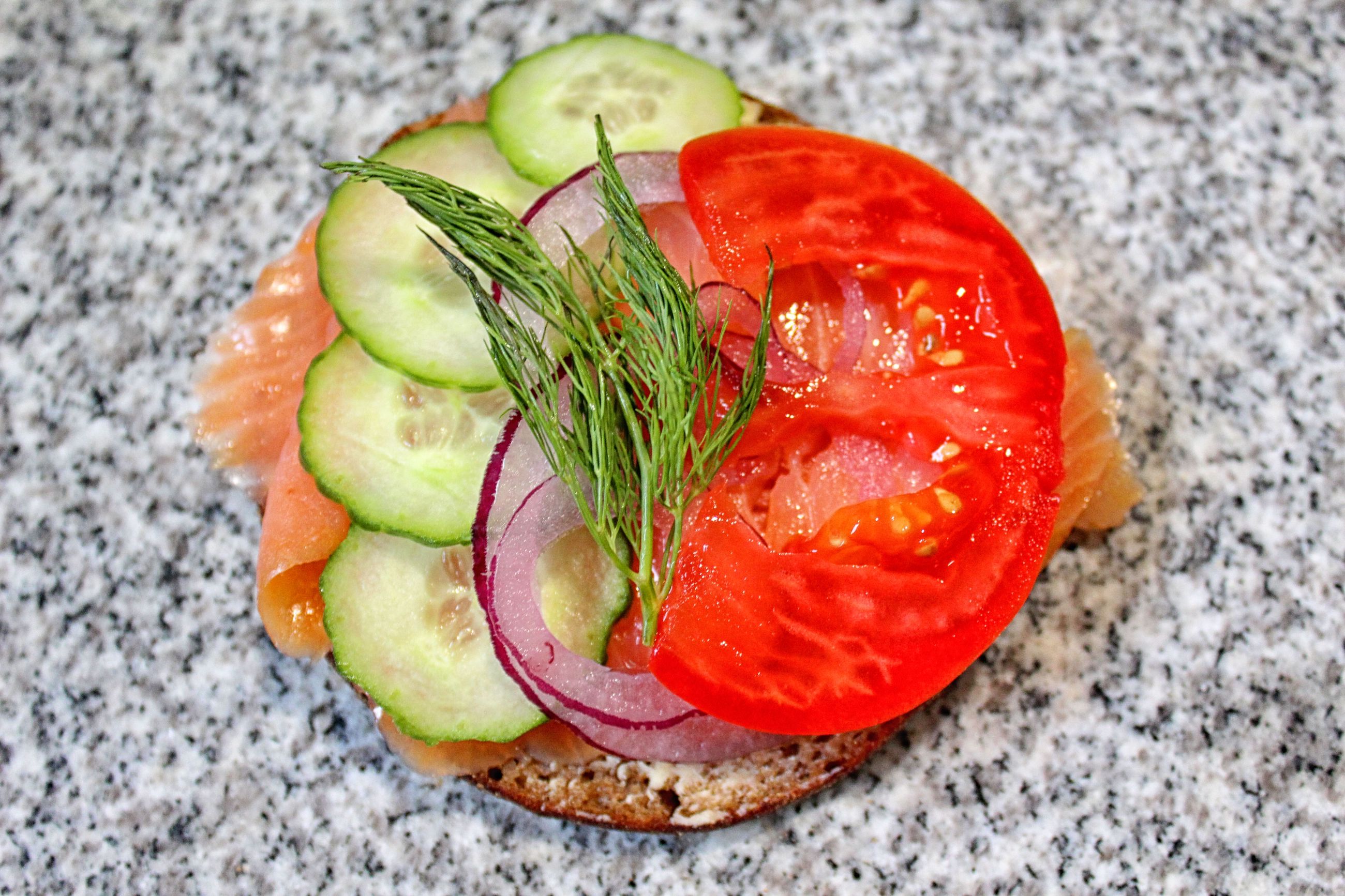








Recent Comments